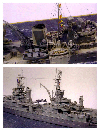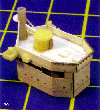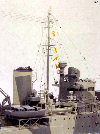 |
Reviewed by Sean Hert |
 |
There have been a number of "How-To" books geared toward the ship modeler over the years, from Mastini's "Ship Modeling Simplified" for the wooden ship builder, to the seminal works by Mike Ashey; "Building and Detailing Scale Model Ships" and "Basics of Ship Modelling". David Griffith has tossed his hat into the ring with this excellent new offering in the hobby "How-To" section.
Griffith's new 144-page hardcover book covers a wide range of topics, from discussing the different common scales and kit types, tools and paint brushes, and different techniques and methodologies for building and detailing your ships. The book has 11 chapters plus an introduction and appendix.
Book Contents
- Introduction
- A Note on Photographs
- What's on the Market
- References and Resources
- Tools, Techniques and Materials
- Basic Construction: Plastic Models
- Basic Construction: Resin Models
- Adding Detail to Smaller Parts
- Bringing it All Together
- Painting and Weathering
- Rigging
- Setting the Scene - Bases and Dioramas
- Model Gallery
- Appendix: Dealers and Suppliers
The book starts out with a review of the hobby; what types of kits are out there, in both scale, material and manufacturer, as well as the growing aftermarket sector of the hobby. It then moves on to discuss the research needed to insure an accurate model in the "References and Resources" chapter. Most modelers collect books to research their favorite subjects, and this hasn't changed with the advent of the Internet. This phenomenon is covered in this chapter as well, listing some websites (including this one!), as well as some options and sources you might not have considered.
Before the books gets to the "meat", that is, the building, part, there is a chapter on the tools used in most model construction and the basic skills to begin ship modelling. There are many topics covered, from the differences in the types of paint brush on the market, cutting, folding photoetch, using a soldering iron for brass structures and a small section on resin casting. All these topics are covered in such a way as to give the novice a introduction to the technique, but by no means is this section an exhaustive step by step manual.
The author chooses 2 subjects to build, one resin and one in plastic, to demonstrate upon. The resin kit being NNT's 1/700 HMAS Sydney, the plastic Tamiya's 1/700 USS Indianapolis CA-35. I found the order in which he showed the builds to be slightly confusing at first; previous books of this type have shown the author building a single kit at a time, taking the reader through all the building steps at once. In this case, after the beginning construction separately in chapters 4 & 5, the author works on the kits simultaniously in the following 5 chapters. I quickly got used to this alternative, and I understand why it was adopted; it avoids repetition of techniques, and actually allows the author to expand upon them by showing complimentary or contrasting views of the kits.
 |
 |
 |
 |
 |
 |
 |
|
The construction chapters end with a view on displays and dioramas. In this chapter is shown some methods for sculpting and painting water, which alone will be enough to warrant the purchase of this book for many modelers.
This book are full of tips that should work for any scale. Each section has something to add, from a different perspective on an old technique or something quite new. His methods for rigging the ship, for instance, are particularly unique and insightful. These steps have the possibility of becoming the new "standard" way of rigging ships. The steps for improving, or replacing details on ships, like tapering your own masts, should prove informative for many modelers, as these are topics that come up time and time again. There is something here for modellers of all skill levels.
My only issue with the book is the "bias" toward 1/700 scale. (Admittedly, I am a 1/350 guy) While the title of the book refers to "small scales", the back cover specifically mentions both of the common model ship scales, 1/350 and 1/700. One example of this I found in the book; when the aftermarket photoetch manufacturer Gold Medal Models is mentioned. In this section, the author states "He chiefly uses stainless steel. As a result, part (sic) are harder to cut, but are much more robust than brass." While GMM's 1/600 and smaller photoetch sets are indeed stainless steel (the 1/700 figure set is brass), his larger line of 1/350 photoetch is all brass (actually, 1/500 and larger).
This book should prove useful and insightful to ship modellers of all scales and skill levels. It is well written, with a light, pleasant tone to the prose, like speaking with someone you know. Dr. Griffith is a talented modeler, and it is quite the labor of love to share his abilities with the world in this book. I heartily recommend it for all ship modelers!
Ship Models from Kits is available direct from the publisher, Seaforth Publishing (an imprint of Pen and Sword books), Amazon.com US and UK, the Naval Institute Press (800-233-8764), and White Ensign Models. Prices vary.
 |
 |
